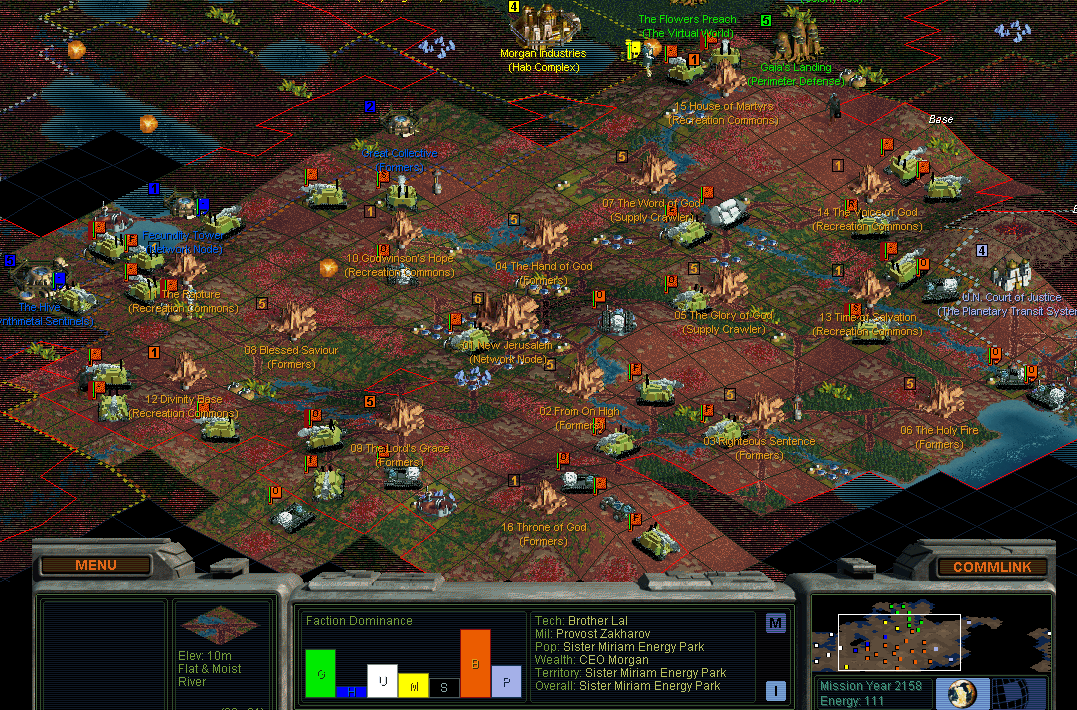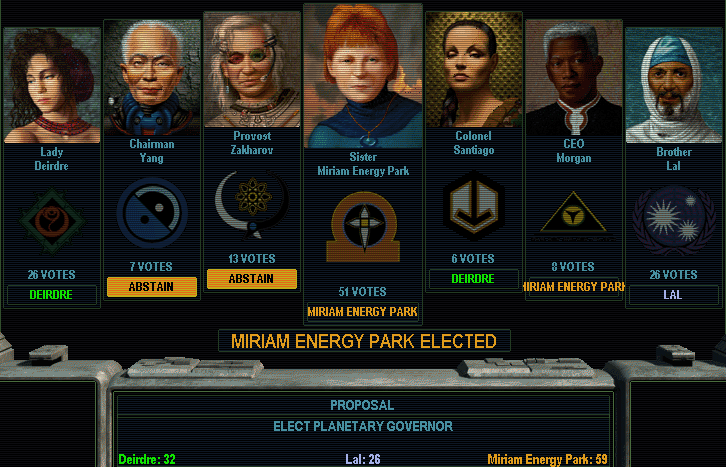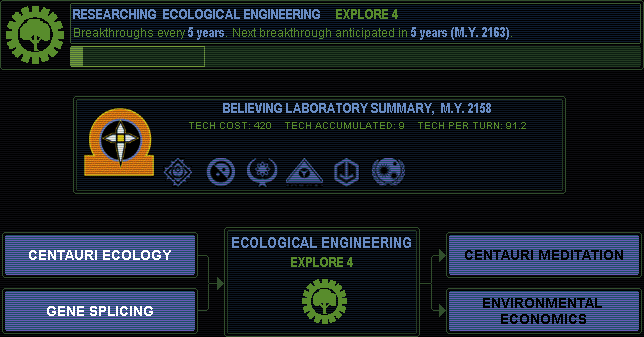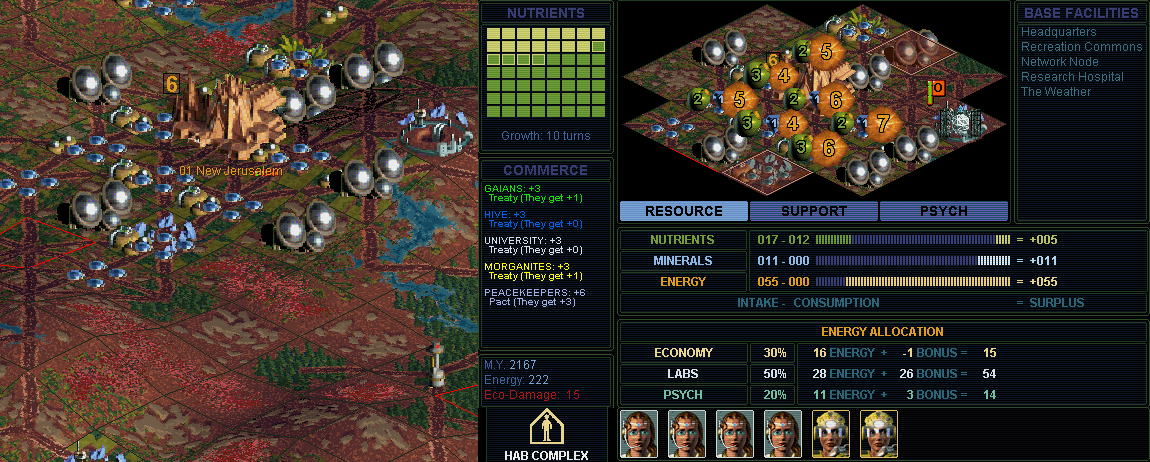Sid Meier's Alpha Centauri - The Lord's Believers

At home, I expanded out to nine bases by year 2140. Short of what the Morgan game had managed with his extra cash, but ahead of the Hive and about the same as the Gaia game would have had without its early conquest of the University.
At least the terraforming was coming along well in accordance with the variant idea. Each of the first five bases had built up to its support limit of 4 formers. Then those formers started rehoming to the newer bases, in anticipation of the Democratic policy dropping the free support. I had planted some forests on arid tiles, constructed farms and solar collectors on moist tiles, and on rainy tiles simply built solar collectors (a farm would be wasted before Gene Splicing.) I also attentively built roads and sensors out to the later base sites. I paid more attention than usual to building sensors underneath upcoming base sites, since a sensor built out in the open would interrupt the energy-grid matrix.
At these 9 bases, I decided to turn the corner and start booming upwards. I didn't quantify it, but it felt like Environmental Economics for uncapped energy production would come faster that way than by expanding horizontally forever. Each base was now building recreation commons, since of course we'd need drone control to build upwards. At the moment I had to run 40% psych slider to handle bureaucracy drones in several bases. I was now making decent money from Free Market plus Wealth, on the order of 25 credits per turn. I saved that money and rushed every rec commons together when it became possible, in year 2142, and dropped psych back to zero.
I actually flubbed my development plan somewhat here, though then compensated and recovered well. This was my initial plan: research Ethical Calculus, build children's creches, adopt Democratic, stay in Free Market for the income, to get the population-boom growth modifiers from the combination of Democratic + creche + Golden Age. That's why 9 bases was my number, since that is the limit before bureaucracy drones with the +2 Efficiency of Democratic. Avoiding that b-drone was important, since as I documented in the Hive thread, an odd-sized base must have no b-drones in order to reach Golden Age without having built the Human Genome Project.
But what went wrong with that plan was the cost of the creches. 50 minerals each was too much for these baby bases. They would take about ten turns to build after the rec commons. I could start the population boom about five turns sooner without them, by way of Democratic + Planned + Golden Age for the growth modifiers. But now the problem was that Planned's efficiency penalty lowered the bureaucracy-drones threshold, so several bases then had one and couldn't reach Golden Age. Turned out the answer to that was simply to build the Human Genome Project anyway. It would cost just 135 produced minerals worth of 5 crawlers (value 150 after SE flipping out of Wealth), much cheaper than nine creches, and then of course it continues to operate for drone mitigation forever.
So this would not be a carefully managed sustainable boom like Gaia or with the Cloning Vats; it would be quick and dirty like the Hive's first round, with bases ending up with all sorts of scattered amounts of size and food and psych and terraforming improvements. The HGP even messily ended up in the second base instead of the HQ because one of the crawlers could reach that base a turn sooner. And I even bought one creche anyway in a base that couldn't find enough psych energy for the golden age. I did plan the schedule out precisely:
- Year 2146: rush supply crawlers in two bases slightly farther out
- 2147: rush supply crawlers in the HQ and second base; switch to Democratic
- 2148: fake switch out of Wealth to cash in the crawlers, then real switch into Planned; build HGP and set 80% psych slider to start Golden Ages
- 2149: each base naturally grew to size 3 on a full food box after Planned had contracted it, and now all the growth modifiers are in effect, so now the bases will boom.
I also made use again of the self-sustaining Golden Age effect. The GA gives +1 Economy rating, which stacks with Wealth to get to +2 without Free Market. A Golden Age thus uses its own +1 energy per square to maintain itself via the psych slider. Once I even used a crawler on energy for one turn just to get enough energy to start a GA that would then sustain itself.

The reason to boom via golden ages instead of building the creches was opportunity cost, or conversely the opportunity advantage of the other items we could build instead. During the population boom, bases short on food built one or two supply crawlers to attend to that. Then they built more colony pods! That is something I haven't done since the Hive game, build more pods while booming. The sticking point for everyone but Hive is the support penalty of Democratic politics, which kills the 10 free minerals for a new base, a very significant setback, that's about five turns difference on being able to rush that base's first former. But once you're in Democratic, you don't really want to go back out of it; you always want the efficiency and will have to come back later for more booming anyway.
Those 10 free minerals are the sticking point... for everyone but the Believers! The inherent support bonus means the Believers are the only faction who can keep the free minerals while running Democratic. As I mentioned in other reports, the best use of a faction ability is often to offset some other negative. The Believers shouldn't duplicate their strength with Fundamentalism, they should effectively get both strengths of that and Democratic.
That's why I paused expansion to boom vertically -- now the core bases could build colony pods faster. This picture shows the results of the sloppy boom - bases haphazardly at sizes 5 or 6 - and also the new outer ring of bases getting prompt terraformer attention. I furthermore got these bases up to speed by rehoming supply crawlers from the now-boomed core bases; that makes a big difference on getting them grown to size 3 and working three forests instead of one. As for the core, most of them were continuing to build more terraformers to start the energy park at my HQ, which was preparing with its network node and then research hospital for the labs multipliers.

After the colony pods, next my bases built supply crawlers for the Weather Paradigm. As often with early projects, I didn't yet have access to expensive enough components to make crawler upgrading worthwhile, so did it by directly cashing in six regular crawlers. Turned out that I got lucky and beat the Gaians by just one turn! That was a strong Gaian base in the jungle, which had started the HGP early then switched to the Weather Paradigm. I knew I had to hurry up, and nailed the timing just right.

Gaia also convened the first Council. It turned out that the missing Sparta was on an offshore island near her. Of course I easily won the election with my newly boomed votes. Although an interesting note was that Deirdre and Lal were both eligible for the vote, exactly tied for second place.

Back in the tech department, that first boom, plus the new bases running Free Market + Wealth and the governor energy, nicely fixed my research rate. The targets were the restriction-lifting techs of Gene Splicing, Ecological Engineering, and Environmental Economics, each of which came in about five turns. Gene Splicing at first fell into a missing-tech hole so I had to look for yet another trade to perturb the modulus again. I asked Lal and he delivered this:

He gave me Applied Physics completely free! I've seen the AI gift a tech on occasion before, but only if the player is far behind. Here I was already on top of the dominance ranking by a small margin. Not that it made any real difference (I had tech trade bait), but this did surprise me. I guess Lal really liked my Democratic social model.

Environmental Economics completed on turn 2167, which turned on the switch for uncapped energy production. Here's a look at my fledgling energy park and its promising productivity. This plus the research hospital on the same turn jumped my overall research rate by about a third, from 115 to 150 labs. Still a long way to go from here, but a nice start.
Yeah, there's one square that doesn't fit the right pattern of mirror and solar stripes, the tile southwest of the capital. That was a rolling-rainy square of over 1000m altitude, so the solar collector was worthwhile there very early on even though it would eventually get replaced into a mirror. I'd also replace the rocky minerals mine with a mirror eventually too.
There's also eco-damage going on here. I wasn't sure how much of that I would get. It's mostly tied to mineral production which would be low, but there is a component for terraforming improvements too, and all the advanced terraforming options (condensors, boreholes, mirrors) have a substantial negative impact. And I wouldn't be building tree farms to raise the eco-damage tolerance. Throughout the game, this was a minor but manageable headache, with empath rovers to kill the worms and lots of formers hanging around to repair the damage. (One subtle advantage of boreholes: functionally immune to eco-damage, a fungus pop grows on top of it but doesn't destroy it, and the borehole yield supersedes the fungus.)
The other thing to note is how much psych we're getting too. I needed 20% psych to maintain order at the other bases -- and this HQ could get a Golden Age from that at the same time! Hence the hab complex (shown for illustration; I'd actually build the creche first.) After buying those, then the HQ would boom to the max size 14 on the growth modifier combination of Democratic + creche + Golden Age from just 20% psych, while staying in Free Market.

My newer bases even boomed the same way as well. I hadn't entirely anticipated this but had come to the right configuration anyway. I stopped my expansion at 18 bases, which is only twice the bureaucracy limit of 9 while in the +2 Efficiency of Democratic, which meant only one b-drone per base. With no superdrones, 4 psych from energy and a doctor, and rec commons, a base at size 3 or 4 could reach Golden Age too and boom the same way. Booming like this was essentially free, every component was things I'd be doing anyway, so I happily took advantage of it. They would reach size 5 this way, as that was when the Golden Age became much more difficult, requiring 8 psych instead of 4 and also more drone control than the single rec commons.
Meanwhile my older bases were also building children's creches now. Then the new bases caught up with the original ones at size 5. Now I went high on the psych slider again (60%) to restart Golden Ages again to boom everything to the limit of size 7, again as Democratic + creche + Golden Age for the growth modifiers. I'm not sure if either the creches or the golden ages were actually better than simply flipping to Planned for two turns instead; probably came out about the same either way.
After the creche and rec commons to enable and control the boom, my bases' build orders went something like former - former - former - former - former - former. I was paying mineral support for most of these. I now wasn't getting much out of the Believers' support bonus; the difference between -2 and 0 support rating is only one unit per base (the other benefit is the 10 minerals per new base that I now wasn't using.) But it still added up to about one extra former per base, which was still significant, as it still took massive terraforming labor to build the mirrors and solars and farms on every tile, while also fixing fungus and sometimes rockiness as well.
And while I'm here, some more words on the energy park.

The maximally optimal pattern for an energy park is rows of mirrors and solar collectors in alternating stripes. A mirror adds +1 energy to every adjacent solar, and functions like a solar itself, except it doesn't receive bonuses from other mirrors. You want to maximize solar-mirror adjacency while minimizing solar-solar and mirror-mirror adjacency. This is the maximal pattern for that: every solar is adjacent to 6 mirrors and every mirror is adjacent to 6 solars.
And there are four possible alignments for the energy park configuration, as shown here. The stripes can run in either diagonal orientation, and there are two positions for which stripe is mirrors and which is solars. All arrangements put exactly 10 of each within a base radius. I chose my alignment based on rocky squares around the HQ, the pattern that would align mirrors onto rocky squares the most. Mirrors are lower yield and get worked last so it's OK if they are on bad rocky tiles, while every solar wants to be worked ASAP including the farmed food yield underneath it. Also, oddly, solars but not mirrors cost more terraforming time on rolling or rocky squares.